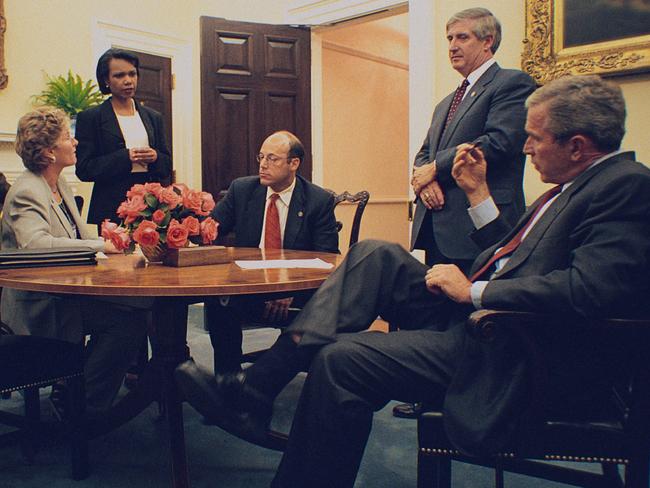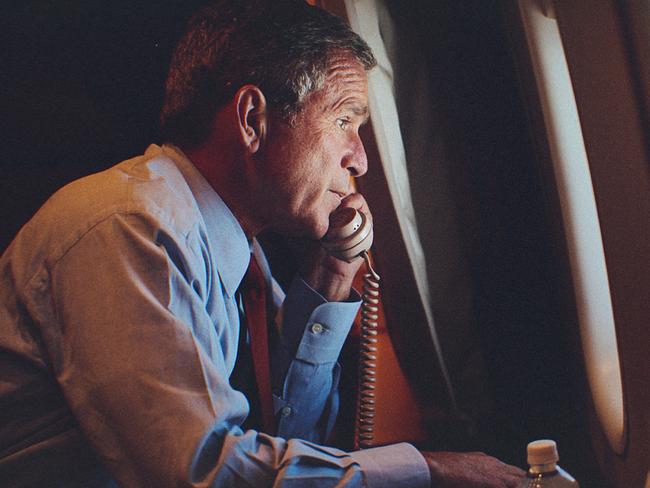
Apple TV+
★★★★½
One minute before George W. Bush delivered one of the most important speeches of his presidency, a fly landed on his Oval Office desk. The US commander-in-chief swatted it dead, picked it up and dropped it on the floor. “Dead fly,” he said.
This everyday moment with an annoying insect is illustrative of the power of the 90-minute documentary 9/11: Inside the President’s War Room. We are taken inside the control room of the most powerful nation on earth as it reels, dazed, shocked and confused, from a terrorist attack on its own soil.
We see video footage and photographs that have not been seen before. We hear new interviews with Bush, vice-president Dick Cheney, national security adviser Condoleezza Rice, secretary of state Colin Powell, White House chief-of-staff Andy Card and adviser-at-large Karl Rove.
It is utterly absorbing. We are allowed inside the minds of people who called the shots of a military, political and financial superpower. On that day, September 11, 2001, they were, for a time, out of their depth, as they readily admit.
“All you could do was look on in horror,” Rove says of watching the World Trade Center towers fall. “No one said anything. Just the thought of all the deaths that could have taken place in that one instant.”
Rove, like Bush, saw the towers fall on television. The photograph of Bush on the phone, his back to the TV, and another of him turned towards the screen, are haunting.
The war room of the title should be plural. Bush was in Florida on September 11. The movie opens at 6.39am with him out running. His main job that day was to visit to an elementary school. “I told him it should be an easy day,” Card remembers.
We know the footage from that school and the moment Card interrupts the president and whispers in his ear. The second plane has hit. “America is coming under attack,” Bush, now 75, recalls. “And I am watching a child read.”
The first war room was a secured location at that school. Bush called Cheney. From there, there were war rooms in air force bases in Louisiana and Nebraska before Bush made it back to Washington. By the time he swatted that fly and made that presidential address, he had flown almost 5000km in Air Force One.
This goes to one of the fascinating parts of this as-it-happened documentary, directed by Adam Wishart with linking narration by the actor Jeff Daniels.
Bush was determined to return to Washington immediately, but the Secret Service stopped him. Their job, as senior agent Dave Wilkinson says in an interview, was to protect the presidency and how to do that was not the call of any individual president.
One of the results was that the airborne president was behind the news. Ordinary Americans on the ground knew more than he did, via the TV news. It was not his fault, but Bush was in catch-up mode for a long time.
The interviews with Air Force One pilot Mark Tillman are also revealing. Twenty years after the event, it’s possible to forget the vastness of the unfathomable moment Bush and his people were dealing with.

“Every plane might have been a missile,’’ Rice says. Air Force One might be a target. So might the White House. And what will Russia think and/or do? Rice talks about her phone conversation with Vladimir Putin.
Bush and Cheney speak openly about the decision, not needed in the end, to shoot down the fourth plane, the one that crashed in Pennsylvania after passengers took on the hijackers.
Card says the one emotion Bush had to keep in check was anger. The man himself says, “I didn’t know who they were yet. But one thing on the to-do list was to kick their ass.” Whose ass was not clear at the time.
As I watched, I wondered when the 43rd president would call his father, the 41st president.
“It was a day full of sadness,’’ Bush says. “I knew mum and dad would be worried about how I was feeling.”
Bush is on Air Force One when he makes the call. When his mother, Barbara, answers she tells her son she and George Sr are “just outside Milwaukee”. There’s not much room for humour in this documentary, but when Bush asks why on earth they’re in Milwaukee and she tells him, even he, 20 years later, laughs at the memory.
There have rightly been a lot of programs made to mark the 20th anniversary of 9/11.
This one is a must-see. It is a rare and privileged entry into the inner sanctum of the inner sanctum at its most challenging time. Of all the people interviewed, only Rice wonders if the attack should have been prevented. “It gnaws at you,” she says.
-
Coming Home in the Dark (MA15+)
In cinemas (NSW, ACT, Victoria dates TBA)
★★★★
It’s hard to believe that it’s close to 30 years since Jane Campion’s The Piano made the movie-going world sit up and take notice. In the time since, her fellow Kiwis have continued to punch above their weight, in both the title fights (Peter “Lord of the Rings” Jackson) and what might be called the under card.
It’s the under card that I am drawn to. Some of the most original films I have seen in recent times are set in New Zealand, from Taika Waititi’s Hunt for the Wilderpeople in 2016 to this year’s Cousins, directed by Ainsley Gardiner and Briar Grace-Smith.
The pitch-black thriller Coming Home in the Dark, the directorial debut of Maori actor and filmmaker James Ashcroft, joins that list.
This is not a feel-good film. It has one of the most shocking opening sequences I have seen in a while. The movie I thought about afterwards was Rowan Woods’s The Boys (1998). So this is the stygian pool we are in – one of menace, fear and no forgiveness.
A family is on a camping trip outside of Wellington. There’s dad Alan (Erik Thomson from Packed to the Rafters), mum Jill (Miriama McDowell) and their two teenage sons Maika and Jordan (real-life brothers Billy and Frankie Paratene).
They pull over the Range Rover and set up a picnic. Two men turn up. One introduces himself as Mandrake (Daniel Gillies). He calls his silent partner Tubs (Matthias Luafutu). Mandrake produces a rifle. “I am a magician,’’ he says. “I make people disappear.”
A campervan pulls into a rest stop nearby. Mandrake tells the family to stay put. They do. When the campervan leaves, he tells them to wave goodbye. They do.
Then he says the sentence that goes to the past, present and future life of this confronting 90-minute movie. He turns a half smile and a cold eye to Alan.
“Later on, when you’re looking back at this occasion, I think that, right there, is going to be the moment you wish you’d done something.”
We learn that Alan, a schoolteacher, worked in a boys’ home early in his career. The racist cruelty inflicted on children at such institutions is important, as it is in the aforementioned film Cousins.
Mandrake orders everyone into the Range Rover, smiles and says, “We’re going home.” From this point we are immersed in a gripping, harrowing movie full of whys.
The questions hover on the surface of this nightmare and lurk beneath it.
When they stop to refuel at a service station, a scene that recalls No Country for Old Men, why doesn’t he/she/they do this? And, at the cold core, why, why, why are Mandrake, who is white, and Tubs, who is Maori, doing this?
Coming Home in the Dark was shot over 20 days on a budget of $1.4m.
It’s a reminder that you don’t need tens of millions to make a good film. I thought of George Miller’s Mad Max (1979, $400,000 budget) and Mad Max: Fury Road (2015, $150m-plus budget). Both good, but is the second one 400 times better?
The must-have ingredients are the story (Coming Home in the Dark is based on a short story by Kiwi writer Owen Marshall), the script, the acting and the eye behind the camera.
All of this was noticed when the film premiered at Sundance Film Festival in January. The debut director from New Zealand has since been signed up to make two Hollywood movies, including Devolution, based on the novel by Max Brooks, son of Mel, whose 2006 zombie novel World War Z was made into a film starring Brad Pitt.
The script of his homegrown debut, co-written by the director and Eli Kent, is tight, the cinematography (Matt Henley), some of it at night as the title suggests, is tense and the performances are superb.
Fans of Packed to the Rafters will see a different Dave Rafter here. Canadian-born Kiwi Gillies was a vampire in the teen TV series The Originals. Here he is just a mortal man and he is truly terrifying. He speaks with the sort of politeness that can only be feared.




9/11: Inside the President’s War Room (PG)